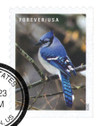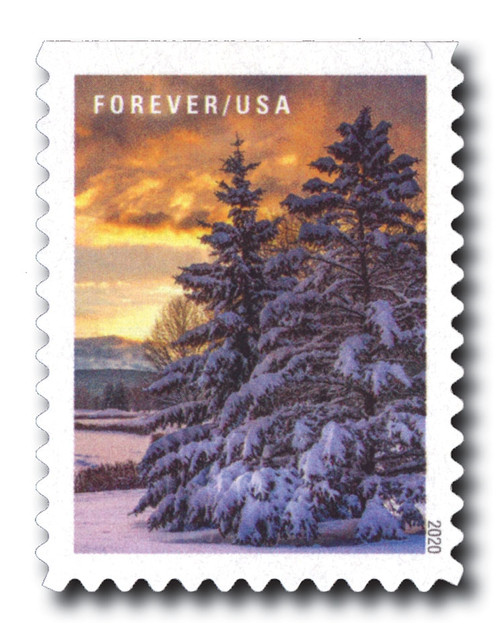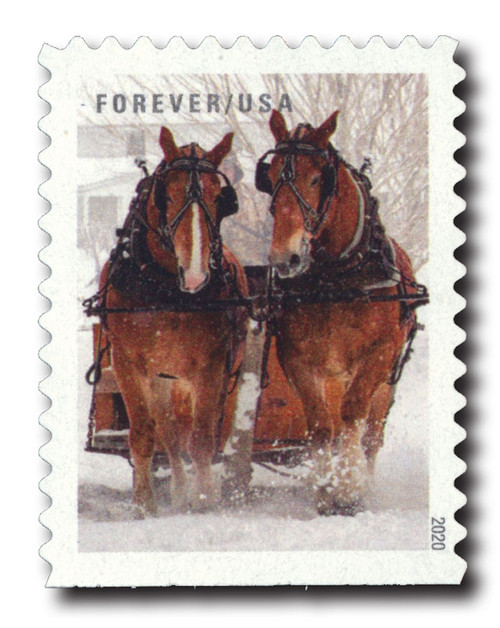
# 5537 - 2020 First-Class Forever Stamps - Winter Scenes: Blue Jay
US #5537
2020 Blue Jay – Winter Scenes
- One of 10 stamps picturing snowy scenes showing off just how beautiful winter can be
Stamp Category: Commemorative
Set: Winter Scenes
Value: 55¢ First Class Mail Rate (Forever)
First Day of Issue: October 16, 2020
First Day City: Winter Park, Florida
Quantity Issued: 400,000,000
Printed by: Ashton Potter (USA) Ltd.
Printing Method: Offset
Format: Double-sided booklets of 20
Tagging: Nonphosphored type III, block tag
Why the stamp was issued: To remember the fun of seeing a brightly colored blue jay on a winter day.
About the stamp design: Pictures a photograph of a blue jay on a tree branch with snow-covered branches in the background.
First Day City: The First Day of Issue Ceremony was held virtually due to the Covid-19 pandemic with a First Day of Issue postmark from Winter Park, Florida.
About the Winter Scenes set: A set of 10 stamp designs picturing different photographs of animals, buildings, and landscapes in winter. Meant as reminders that winter isn’t all cold and snow, it has moments of real beauty, too.
History the stamp represents: Blue jays are some of the most common backyard visitors in North America. During the summer months, they spend their time in breeding pairs, often chasing other birds away. However, during the cold winter months, their behavior changes.
Groups of around 15 blue jays sometimes gather together in the winter to form what is known as a foraging flock. These groups may be more successful at finding food during harsh times thanks to more birds scouting at once. That means when one bird finds food, every member of the flock is able to take advantage of it. Blue jays are also excellent guards. When they spot a predatory bird such as an owl or hawk, they alert all birds in the area. The more blue jays that are around, the harder it is for a large bird of prey to get the drop on one.
In addition to scouting for possible food sources, blue jays also depend on hidden caches they make during the fall months. These are usually made up of acorns buried in the ground. However, like squirrels and other animals that store food, sometimes blue jays do not come back for every cache. This means many uneaten acorns are able to germinate and grow into oak trees. In fact, blue jays have become the main way several species of oak are able to spread. It is amazing the big impact one animal can make.
US #5537
2020 Blue Jay – Winter Scenes
- One of 10 stamps picturing snowy scenes showing off just how beautiful winter can be
Stamp Category: Commemorative
Set: Winter Scenes
Value: 55¢ First Class Mail Rate (Forever)
First Day of Issue: October 16, 2020
First Day City: Winter Park, Florida
Quantity Issued: 400,000,000
Printed by: Ashton Potter (USA) Ltd.
Printing Method: Offset
Format: Double-sided booklets of 20
Tagging: Nonphosphored type III, block tag
Why the stamp was issued: To remember the fun of seeing a brightly colored blue jay on a winter day.
About the stamp design: Pictures a photograph of a blue jay on a tree branch with snow-covered branches in the background.
First Day City: The First Day of Issue Ceremony was held virtually due to the Covid-19 pandemic with a First Day of Issue postmark from Winter Park, Florida.
About the Winter Scenes set: A set of 10 stamp designs picturing different photographs of animals, buildings, and landscapes in winter. Meant as reminders that winter isn’t all cold and snow, it has moments of real beauty, too.
History the stamp represents: Blue jays are some of the most common backyard visitors in North America. During the summer months, they spend their time in breeding pairs, often chasing other birds away. However, during the cold winter months, their behavior changes.
Groups of around 15 blue jays sometimes gather together in the winter to form what is known as a foraging flock. These groups may be more successful at finding food during harsh times thanks to more birds scouting at once. That means when one bird finds food, every member of the flock is able to take advantage of it. Blue jays are also excellent guards. When they spot a predatory bird such as an owl or hawk, they alert all birds in the area. The more blue jays that are around, the harder it is for a large bird of prey to get the drop on one.
In addition to scouting for possible food sources, blue jays also depend on hidden caches they make during the fall months. These are usually made up of acorns buried in the ground. However, like squirrels and other animals that store food, sometimes blue jays do not come back for every cache. This means many uneaten acorns are able to germinate and grow into oak trees. In fact, blue jays have become the main way several species of oak are able to spread. It is amazing the big impact one animal can make.














